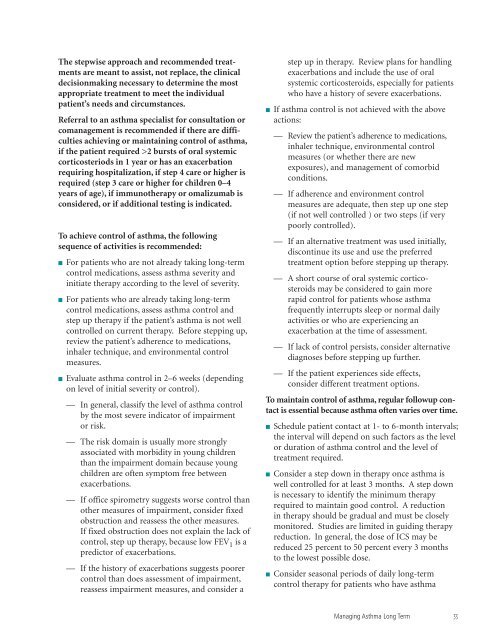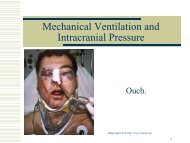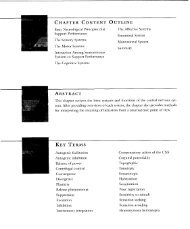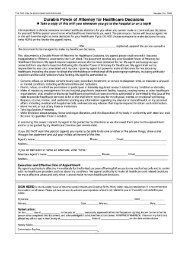Guidelines for the Diagnosis and Management of Asthma
Guidelines for the Diagnosis and Management of Asthma
Guidelines for the Diagnosis and Management of Asthma
Create successful ePaper yourself
Turn your PDF publications into a flip-book with our unique Google optimized e-Paper software.
The stepwise approach <strong>and</strong> recommended treatments<br />
are meant to assist, not replace, <strong>the</strong> clinical<br />
decisionmaking necessary to determine <strong>the</strong> most<br />
appropriate treatment to meet <strong>the</strong> individual<br />
patient’s needs <strong>and</strong> circumstances.<br />
Referral to an asthma specialist <strong>for</strong> consultation or<br />
comanagement is recommended if <strong>the</strong>re are difficulties<br />
achieving or maintaining control <strong>of</strong> asthma,<br />
if <strong>the</strong> patient required >2 bursts <strong>of</strong> oral systemic<br />
corticosteriods in 1 year or has an exacerbation<br />
requiring hospitalization, if step 4 care or higher is<br />
required (step 3 care or higher <strong>for</strong> children 0–4<br />
years <strong>of</strong> age), if immuno<strong>the</strong>rapy or omalizumab is<br />
considered, or if additional testing is indicated.<br />
To achieve control <strong>of</strong> asthma, <strong>the</strong> following<br />
sequence <strong>of</strong> activities is recommended:<br />
■ For patients who are not already taking long-term<br />
control medications, assess asthma severity <strong>and</strong><br />
initiate <strong>the</strong>rapy according to <strong>the</strong> level <strong>of</strong> severity.<br />
■ For patients who are already taking long-term<br />
control medications, assess asthma control <strong>and</strong><br />
step up <strong>the</strong>rapy if <strong>the</strong> patient’s asthma is not well<br />
controlled on current <strong>the</strong>rapy. Be<strong>for</strong>e stepping up,<br />
review <strong>the</strong> patient’s adherence to medications,<br />
inhaler technique, <strong>and</strong> environmental control<br />
measures.<br />
■ Evaluate asthma control in 2–6 weeks (depending<br />
on level <strong>of</strong> initial severity or control).<br />
— In general, classify <strong>the</strong> level <strong>of</strong> asthma control<br />
by <strong>the</strong> most severe indicator <strong>of</strong> impairment<br />
or risk.<br />
— The risk domain is usually more strongly<br />
associated with morbidity in young children<br />
than <strong>the</strong> impairment domain because young<br />
children are <strong>of</strong>ten symptom free between<br />
exacerbations.<br />
— If <strong>of</strong>fice spirometry suggests worse control than<br />
o<strong>the</strong>r measures <strong>of</strong> impairment, consider fixed<br />
obstruction <strong>and</strong> reassess <strong>the</strong> o<strong>the</strong>r measures.<br />
If fixed obstruction does not explain <strong>the</strong> lack <strong>of</strong><br />
control, step up <strong>the</strong>rapy, because low FEV 1 is a<br />
predictor <strong>of</strong> exacerbations.<br />
— If <strong>the</strong> history <strong>of</strong> exacerbations suggests poorer<br />
control than does assessment <strong>of</strong> impairment,<br />
reassess impairment measures, <strong>and</strong> consider a<br />
step up in <strong>the</strong>rapy. Review plans <strong>for</strong> h<strong>and</strong>ling<br />
exacerbations <strong>and</strong> include <strong>the</strong> use <strong>of</strong> oral<br />
systemic corticosteroids, especially <strong>for</strong> patients<br />
who have a history <strong>of</strong> severe exacerbations.<br />
■ If asthma control is not achieved with <strong>the</strong> above<br />
actions:<br />
— Review <strong>the</strong> patient’s adherence to medications,<br />
inhaler technique, environmental control<br />
measures (or whe<strong>the</strong>r <strong>the</strong>re are new<br />
exposures), <strong>and</strong> management <strong>of</strong> comorbid<br />
conditions.<br />
— If adherence <strong>and</strong> environment control<br />
measures are adequate, <strong>the</strong>n step up one step<br />
(if not well controlled ) or two steps (if very<br />
poorly controlled).<br />
— If an alternative treatment was used initially,<br />
discontinue its use <strong>and</strong> use <strong>the</strong> preferred<br />
treatment option be<strong>for</strong>e stepping up <strong>the</strong>rapy.<br />
— A short course <strong>of</strong> oral systemic corticosteroids<br />
may be considered to gain more<br />
rapid control <strong>for</strong> patients whose asthma<br />
frequently interrupts sleep or normal daily<br />
activities or who are experiencing an<br />
exacerbation at <strong>the</strong> time <strong>of</strong> assessment.<br />
— If lack <strong>of</strong> control persists, consider alternative<br />
diagnoses be<strong>for</strong>e stepping up fur<strong>the</strong>r.<br />
— If <strong>the</strong> patient experiences side effects,<br />
consider different treatment options.<br />
To maintain control <strong>of</strong> asthma, regular followup contact<br />
is essential because asthma <strong>of</strong>ten varies over time.<br />
■ Schedule patient contact at 1- to 6-month intervals;<br />
<strong>the</strong> interval will depend on such factors as <strong>the</strong> level<br />
or duration <strong>of</strong> asthma control <strong>and</strong> <strong>the</strong> level <strong>of</strong><br />
treatment required.<br />
■ Consider a step down in <strong>the</strong>rapy once asthma is<br />
well controlled <strong>for</strong> at least 3 months. A step down<br />
is necessary to identify <strong>the</strong> minimum <strong>the</strong>rapy<br />
required to maintain good control. A reduction<br />
in <strong>the</strong>rapy should be gradual <strong>and</strong> must be closely<br />
monitored. Studies are limited in guiding <strong>the</strong>rapy<br />
reduction. In general, <strong>the</strong> dose <strong>of</strong> ICS may be<br />
reduced 25 percent to 50 percent every 3 months<br />
to <strong>the</strong> lowest possible dose.<br />
■ Consider seasonal periods <strong>of</strong> daily long-term<br />
control <strong>the</strong>rapy <strong>for</strong> patients who have asthma<br />
Managing <strong>Asthma</strong> Long Term<br />
33





